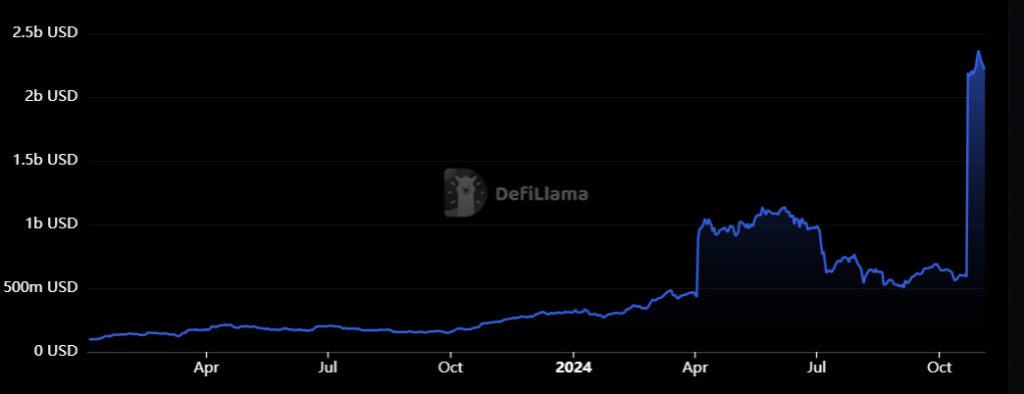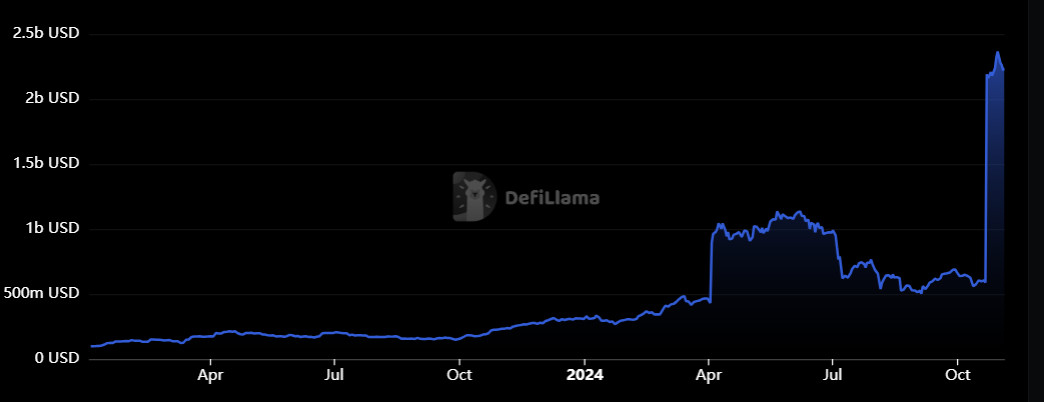
Gregory Pudowski
Posted: Nov 8, 2024 10:24 AM Updated: Nov 8, 2024 10:24 AM
XLink, the protocol integrating BTC into the growing decentralized finance (DeFi) economy, recently released a white paper detailing its completely unique approach to the interoperability of blockchains with other ecosystems.
The protocol seeks to alleviate the most pressing bottlenecks hindering the growth of Bitcoin-based DeFi (more popularly known as BTCFi) using a unique framework called “Bitcoin-centric chain abstraction.”
Currently, BTC’s nascent economy has a total value locked (TVL) of $2.23 billion, more than 22 times what it was in January 2023.

Total funds locked across various BTC protocols (Source: Defillama)
The white paper outlines the evolution of XLink from a simple cross-chain bridge within the Bitcoin-DeFi platform ALEX to overcome the limitations of some digital assets (e.g. limited smart contract functionality).
What is a ‘Bitcoin-centric chain abstraction’?
XLink’s core innovation comes from its Bitcoin-centric chain abstraction framework that allows BTC holders to interact with various networks using only their Bitcoin wallet. This eliminates the need to manage multiple storage solutions or have extensive knowledge of cryptography-related terminology.
Technically speaking, the abstraction layer is supported by an intent-based routing engine that automatically translates user intent into executable workflows across a variety of networks.
Instead of requiring users to understand the complexities of cross-chain transactions, the system allows the protocol to automatically handle all technical implementation details, allowing users to specify their desired outcome.
Technical architecture and security measures
According to the white paper, XLink’s improved digital architecture offers several notable security features, including a ‘direct event verification’ mechanism that differs from existing bridging solutions.
Instead of relying on external validators, the protocol validates Bitcoin events within its own framework, potentially reducing the risk of errors and external manipulation that can occur in traditional systems.
The protocol’s security infrastructure is further strengthened by an institutional-grade Multi-Party Computation (MPC) wallet. Developed in collaboration with existing storage technology providers Cobo and Fireblocks, the product requires multiple signatures to authorize transactions and adds an additional layer of security for user assets.
In addition, our partnership with Coincover also provides disaster recovery solutions to address issues related to untimely outages or operational interruptions.
Finally, to maintain a high level of decentralization and security, XLink has deployed a validator network that combines both signature and non-signature validators. This hybrid approach builds a two-tier security model that prevents all kinds of network takeover attempts while encouraging community participation in strengthening network security.
Exploring XLink’s governance operations
XLink’s operations are currently overseen by XLinkDAO, a decentralized autonomous organization (DAO) that ensures delocalized governance through decentralized stakeholder participation.
A long-term collaboration with the ALEX Lab Foundation has facilitated the integration of Bitcoin Oracles, a cross-chain messaging and consensus layer that enables secure communication between Bitcoin’s off-chain computation engines, into their respective digital frameworks.
For institutional users, XLink served as a bridge to facilitate seamless participation in the Bitcoin economy. The protocol’s infrastructure specifically caters to the needs of family offices, pension funds, and high-net-worth individuals seeking secure exposure to BTCFi.
Strategic partnerships and technology integration
Earlier this month, XLink announced that it was collaborating with the NEAR Protocol to leverage its unique ‘chain signature’ technology, allowing smart contracts to execute transactions across multiple blockchains while increasing the platform’s throughput and confirmation speed.
Additionally, NEAR protocol integration improves the efficiency of XLink’s previously mentioned Bitcoin oracles while also signifying a shift from traditional “lock and mint” mechanisms to more efficient account-based routing for cross-chain asset transfers.
As a result, users will have a more efficient experience, especially when interacting with L2 smart contracts (since all the user has to do is use their Bitcoin wallet to manage transactions).
Finally, XLink aims to integrate with major ecosystems, including Stack and Core Chain, to create a more cohesive DeFi environment where users can leverage the strengths of multiple networks while retaining Bitcoin as their native asset.
Going forward, it will be interesting to see how BTCFi continues to mature and whether XLink’s Bitcoin-centric chain abstraction paves the way for future blockchain interoperability solutions. Exciting times lie ahead!
disclaimer
In accordance with the Trust Project Guidelines, the information provided on these pages is not intended and should not be construed as legal, tax, investment, financial or any other form of advice. It is important to invest only what you can afford to lose and, when in doubt, seek independent financial advice. We recommend that you refer to the Terms of Use and help and support pages provided by the publisher or advertiser for more information. Although MetaversePost is committed to accurate and unbiased reporting, market conditions may change without notice.
About the author
Gregory, a digital nomad from Poland, is not only a financial analyst but also a valuable contributor to various online magazines. With extensive experience in the financial industry, his insights and expertise have been recognized in numerous publications. Making good use of his free time, Gregory is currently focusing on writing books on cryptocurrency and blockchain.
more articles


Gregory, a digital nomad from Poland, is not only a financial analyst but also a valuable contributor to various online magazines. With extensive experience in the financial industry, his insights and expertise have been recognized in numerous publications. Making good use of his free time, Gregory is currently focusing on writing books on cryptocurrency and blockchain.

